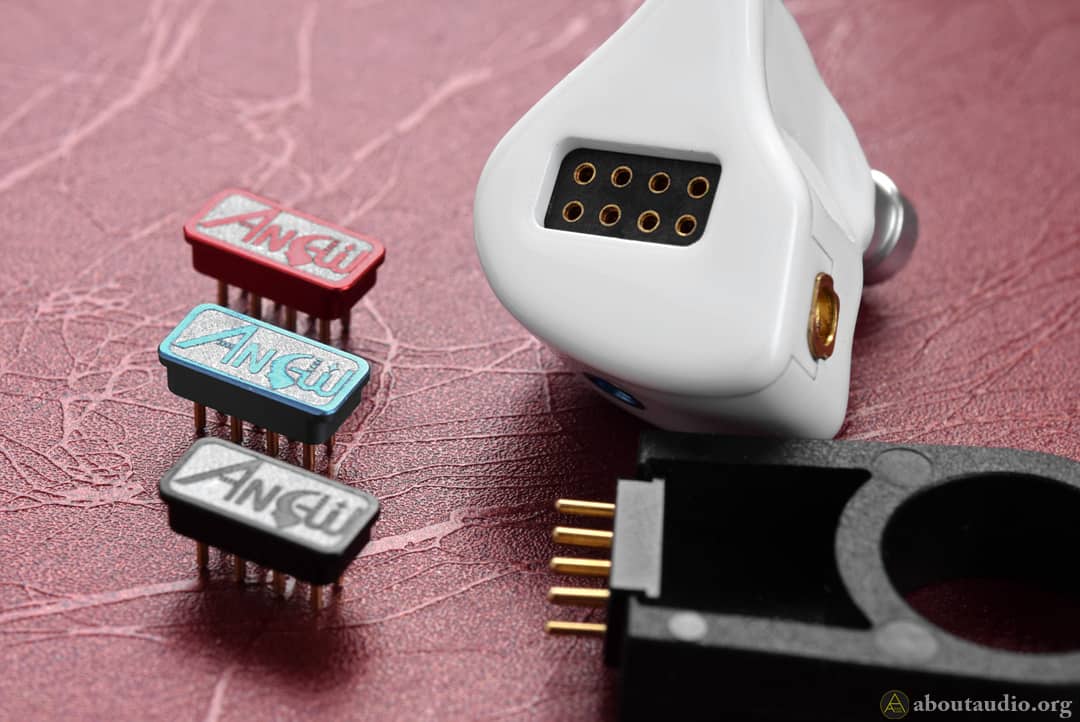 Anew X-One Review: Hypnotize
Anew X-One Review: Hypnotize
Anew is one of those new brands, along with IKKO, that I have encountered without any expectations yet got myself hit hard on the back of my head. In case you would ever ask me why it was due to their quality being too good for the price and for completely new brands. The U1 was the very first IEM released by Anew and that particular IEM got me much impressed – however, not a single background info was able to be found only except a rumor that Anew was created by a former LZ engineer. After some lengthy gap, Anew recently released its second IEM, the X-One (or X1). Let us take a look and see how it performs and compares to its rivals.

 Packaging
Packaging
X-One is packaged in a white box added with technical details on the back. Other than the earpieces, it comes with a stock 3.5mm cable, 3 pairs of white silicone tips, 4 pairs of transparent silicone tips, a Pelican-style hard case, 3 pairs of modules, a module tool, a velcro tie, and some paperwork. The stock tips are soft yet a bit flimsy, leaving a margin for some improvements. However, the hard case is very well made as the casing is very sturdy with soft rubber padding applied in the inside. X-One also features a special module system and will be soon covering it down below.
 Earpieces
Earpieces
X-One is tuned with a 4BA+1DD configuration, comprised of a 6mm carbon diaphragm driver, two custom BAs for the mid, and another set of two custom BAs for the high. Its outer cavity is made of aluminum alloy machined with precision, which is then coated with an extra layer of anti-scratch coating on the surface. The earpieces are very well machined and coated to the point where the surface feels spotless and smooth as ceramic. Its over-ear shape design provides a comfortable, hassle-free fit. The nozzles have a good thickness to it that scales to about T500 yet does not negatively affect the fit as their lengths are not particularly long. The cavity also shows a decent weight where the earpieces are not light but definitely not heavy.
The biggest key feature of X-One is its switchable modules. The slightly bulged-out Anew logo on the faceplates is in fact a module that affects the crossover, leading the earpieces to produce different types of sound. There are three types in total – the default red, blue, and black. Anew describes that each module enhances the highs, the lows, and low/mids. Here I purposely used the word “describe” as the outcome was rather different for me and the details will be covered in the latter part of this review.
 Cable
Cable
A quality stock cable comes with X-One not only to match the looks with the color of the earpiece but to also live up to its sound quality. The cable is made of 4-braided silver-plated pure copper wires with the termination of mmcx-3.5mm. The cable is suitable for outdoor usages as it is light, soft, and microphonics-free.
 Sound impression – Lows
Sound impression – Lows
*Current and following impressions are based on the default (red) filter
Lows are bold and large but executed in a very clean manner. Ultra lows dive deep and fast, then creating an abundant body. Upper lows are not really bulged out but would maintain a leveled intensity as the ultra lows. Interestingly, the end result is a considerably flat and highly stable bass. However, the bass response is nowhere weak as the bass rumbles are thick and bold along with tight and weighty punches. Of course, those impacts are also done in a calm manner, showing more of a well-tamed, virtuous attitude. The bass would not be flooding in the ears, but it definitely would not be weak in its presence.
I am impressed with its bass extension. The quantity of the bass itself is only slightly elevated from flat, yet its body is bold and the ultra-low extension, ironically, is even superior to many other IEMs with boosted bass. X-One’s bass presentation makes it easy to focus solely on the texture and the depth of the bass with barely any stuffiness. Lows are positioned on the rock bottom, showing thorough and wide domination throughout the lower side of the headroom. In terms of quantity, ultra lows show a similar amount as other slightly v-shaped earphones have for their upper lows. Upper lows, on the other hand, has a similar or mildly lesser quantity as ultra lows.
 Sound impressions – Mids
Sound impressions – Mids
Mids are tender with a tone that is straight out sexy. It takes place close to the ears that scale large and full-bodied. In terms of positioning, mids are clearly distinguished from the lows but not disconnected, as the lows are kept leveled and rather flat. Since the upper lows are composed with less bouncing that results in a bit of airy area between the lows and mids, letting the vocals to occupy its own place with no chances of bass leakage. There is a mild coloration present on the vocals, yet it does not come across bothering as it does not mess up the neutrality – once compared to photography, X-One’s coloration is like a mild filter or an enhancement applied to a picture where it adds mood to the picture yet not abandoning the white balance.
X-One shows neutral thickness on mids that mildly tips over to the slimmer side, satisfying both male and female vocals. Upper mids around the sibilance area are well handled, restraining only the spikes while keeping the freshness unleashed. The thickness would thin out in the edge as the vocals go through the sibilance area. Keep in mind that tracks that already have evident sibilance within it may amplify their sibilance. Other than that, this slight emphasis adds thrill and freshness to the vocals rather than getting hot or giving off any disturbing impressions. It has a fairly well spectrum in brightness, presenting a mild coolness as default. Lower mids possess a bit more warmth and would get shinier as it goes up towards the treble.
 Sound impressions – Treble, etc.
Sound impressions – Treble, etc.
Highs are appealing, fruity, and highly analytic – with an airy, cool tone, highs bring a mildly sweet aftertaste. Thin strands and splashes would be finely separated make themselves and identifiable. Treble snaps deliver clear transparency with coolness, adding taste to the music. It is not a type of treble that vividly pierces into the ears nor it gets hot, so there are low chances for them to ever get fatiguing. Highs are a bit more organic in tone but not soften in rigidity. Since that, metal instruments deliver metallic tingles as it should and would not be overdone. Trebles show an instant response that gives a quick, snappy impression.
The soundstage is quite on the larger side. Headroom would extend wide towards sideways, but X-One especially does a good job expanding the up and down spacing. The listening would become more dynamic and involving for the listener as the music gets deeper in depth. Separation is simply great. All instruments and layerings are clearly distinguished and grouped that musically come together all in one piece. The texture feels tightly-packed and soothing which also knows how to get meticulous once required.
 Comparisons
Comparisons
–LZ A6-
A6 carries more quantity and vividness on the upper-end where it sometimes shows some portion of heat. Without crossing the barrier, mids show a colorful and richness-enhanced presentation. For the bass, A6 shows quite a decent bass extension but only mildly emphasized in quantity. Since that, the sound gets very exciting and rich, yet the upper ends would get hot relatively faster as well as the low ends not being plentiful enough for delivering a strong slam.
While X-One and LZ-A6 both take quite a similar path in the overall sound signature, Anew takes the lead here. Lows are better established by achieving more depth, thickness in color, and quantity. The low-ends are larger and punchier, making their presence strong enough to handle bass-heavy genres while keeping the three bands balanced. Mids are also better controlled by keeping its center of gravity relatively lower than A6 which gives better stability to the vocals. The tone is more neutral with more coherency, presenting the voices in an unexaggerated yet still in a rich manner. Lastly, the trebles are calmer and smoother where the airiness and clarity are preserved but just refrained in carrying out the heat.
-Shozy BG-
Since BG shows more of a calm, reference sound signature, the “3D effect” from the staging is not particularly emphasized with lesser reverbs, keeping the mood and the headroom linear and original. Since that, the sound signature is closer to a mildly w-shaped signature where all three bands are just slightly emphasized from being flat. This also leads BG to have the sound more closely located than X-One, therefore giving a more “whispering” feeling to the ears.
X-One shows a stronger W-shaped sound signature with more expansive and grand staging. The reverbs are further matured within the housing, giving a fuller, bigger body to the sound. Throughout the spectrum, the sound gets more dynamic and vivid in colors – bass showing more thickness/body/depth, mids scaling larger, and highs showing more finesse. Speaking of colors, X-One shows slightly more coloring on the trebles but not in a big margin as this is relatively said. Performance-wise, X-One outdoes BG only by a slight degree – their sound signatures and charms are a lot different, so this would be more of a matter to do with preferences. BG for a flat, analyticity-focused signature and X-One for W-shaped, musicality-focused signature.
The modules
By applying the blue module, the sound gains visibly more air throughout the whole spectrum as well as boosted clarity on the upper end. Lows still create a full body with equally thick color, yet the weight brought from the low-end slightly decreases. However, the change is not significant enough to make the bass light. Mids would show higher elevation with much air without getting off-tone or produce spiky sibilance. Highs would also gain more air and purity, delivering extra crisp and flutters. Overall, the sound is brought to a visible yet subtle change that does not get quirky.
While the blue module further expands the space between the sounds, the black module takes the opposite approach which is to mildly condense the sound. This leads the overall sound to gain more density and meat, plus making the mids to level out more evenly with the other two bands – lows and highs. However, all these changes are very subtle to the point where it would not be so easy to identify the difference at once, so the original sound characteristics and signature are still going towards the same direction.
 Verdicts
Verdicts
It took a while for Anew to put up with a new product as an Anew fan who has been looking forward to their new works, though the wait sure has been worth as X-One delivered the same sensation I have felt when I first encountered to U1. Keeping the genetics of U1, X-One shows a bold advancement in all aspects – the sound, build, functionality, and accessories. Even when we look at it objectively, its performance and sound quality are powerful enough to threaten other IEMs in the same price range or even higher. If you have been looking for an IEM with a full and rich W-shaped sound, the chances are high that you would fall in love big time with this one from Anew.
Thanks to Anew for providing X-One in exchange for an honest impression/feedback.
I am not affiliated with Anew and none of my words were modded or asked to be changed.



